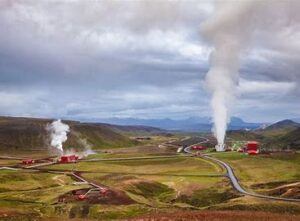Imagine tapping into the Earth’s innermost heat to keep our homes cozy and our lights on. That’s geothermal energy for you. It’s a type of renewable energy that comes from the natural heat stored beneath the Earth’s surface. Unlike other renewable sources that depend on the sun or wind, geothermal energy is available 24/7, making it a powerhouse in the realm of sustainable resources.

People have benefited from the Earth’s geothermal offerings for thousands of years, from the ancient Romans using hot springs for bathing to modern countries harnessing it for electricity. It’s fascinating to note that while geothermal energy has been part of human life for centuries, its potential is far from fully realized.
As a source that is both vast and underused, geothermal energy holds promise for our energy future. It stands apart in its ability to deliver consistent power regardless of the weather, distinguishing it from more variable renewable resources. This reliability is what sets geothermal up as a star player in the journey towards a cleaner energy landscape.
The Engine Under the Earth: How Geothermal Energy Works.
To comprehend how geothermal energy is harnessed, one must first understand the concept of geothermal gradients. This term refers to the increase in temperature that occurs as you descend into the Earth’s interior. Generally, this gradient averages about 25 to 30 degrees Celsius per kilometer in the Earth’s crust.

The process of converting geothermal activity into usable energy begins deep beneath our feet. Here, the heat from the Earth’s core, which reaches temperatures akin to the surface of the sun, naturally heats up water in the Earth’s crust, creating a renewable source of energy. Engineers tap into this reservoir by pumping the heated water or steam to the surface, where it can be used directly for heating or to generate electricity in geothermal power plants.
Geothermal power plants come in three primary varieties, each suited to a particular type of geothermal resource. Dry steam plants use steam directly from geothermal reservoirs. Flash steam plants pull up hot water, which is allowed to boil as it rises, creating steam to drive turbines. Finally, binary cycle power plants transfer heat from geothermal water to another liquid with a lower boiling point, which then vaporizes to turn the turbines.
Apart from large scale power generation, geothermal energy also heats and cools homes through ground source heat pumps. These systems utilize the relatively constant temperature of the ground a few meters below the surface as a source for heating in the winter and cooling in the summer, offering an efficient alternative to conventional HVAC systems.
It’s crucial to underscore the versatility of geothermal energy—it’s not just a source of electricity but also a means of direct heating. From residential heating solutions to nurturing greenhouse plants and even for drying various crops, the applications of geothermal energy are diverse and far-reaching.
Origins of Endless Warmth: Where Geothermal Energy Comes From.
You may have wondered where the seemingly inexhaustible supply of geothermal energy originates. It’s a journey to the center of the Earth, quite literally. The relentless heat that powers geothermal sources comes from deep beneath Earth’s crust, from its very core. The core’s high temperatures are a result of the radioactive decay of minerals and the residual heat from the planet’s formation more than four billion years ago.
This immense heat is continuously conducted towards the surface, creating a temperature gradient. In certain areas known as geothermal hotspots, the movement of tectonic plates and volcanic activity bring this heat closer to the surface. Places like Iceland and New Zealand are prime examples, where the Earth’s crust is thinner, allowing easier access to geothermal energy.

But it’s not just these hotspots that hold geothermal potential. Anywhere you go, if you drill deep enough, you’ll find increased temperatures. However, the practicality of reaching these depths varies, which is why regions with naturally elevated subsurface temperatures and upwelling of geothermal fluids are ideal for tapping into this power source.
As we transition from where geothermal energy comes from to how we stand to benefit from harnessing it, it’s critical to understand the sustainability aspect. Geothermal energy offers an unfailing base-load power source, essentially independent of weather and certainly of day or night. It’s an undercurrent of energy that, if leveraged wisely, can consistently support the grid.
Embracing Earth’s Inner Flame: The Array of Advantages Geothermal Energy Offers.
Turning to the core of the earth for its endless supply of heat not only epitomizes sustainability, but it stands to significantly slash our carbon footprint. Unlike fossil fuels, geothermal energy is a constant. Unlike solar and wind, it doesn’t depend on the weather. This reliability is paired with minimal environmental impact, making it a pillar for future green energy solutions.
But it’s not just the environment that benefits. Economically, geothermal projects usher in ample job opportunities, from research and development to construction and ongoing operations. Communities situated near geothermal plants can experience a boon, enjoying a stable source of income and invigorated local economies.
The resilience of geothermal energy systems underpins their value. Long-lasting and designed to withstand the test of time, they provide a steadfast source of energy. Maintenance requirements are relatively low, and once established, these systems operate with impressive autonomy.
One aspect of geothermal energy that can’t be overstressed is its contribution to energy independence. This form of energy is locally sourced, meaning it can reduce a nation’s reliance on foreign oil and gas. It fosters not just a greener, but a more self-sufficient society, with each geothermal facility further cementing local security in energy supply.
